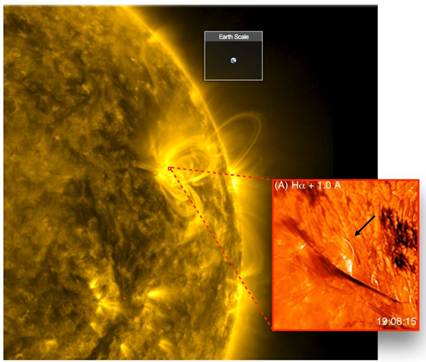Miniature Plasma Loops

- 11 Jul 2025
In News:
A significant discovery by Indian and international astronomers has unveiled the existence of miniature plasma loops in the lower layers of the Sun’s atmosphere, shedding new light on how the Sun stores and releases magnetic energy—a long-standing mystery in solar physics.
- These loops are tiny in scale, measuring 3,000–4,000 km in length and less than 100 km in width, making them difficult to detect with earlier instruments. Despite their short lifespan of only a few minutes, they offer crucial insights into magnetic reconnection—a process where tangled magnetic field lines snap and realign, releasing immense energy.
- The research was led by scientists at the Indian Institute of Astrophysics (IIA), Bengaluru, under the Department of Science and Technology (DST), in collaboration with global institutions including NASA, the Max Planck Institute, and the Big Bear Solar Observatory (BBSO).
Key Findings and Instruments Used
- The team used high-resolution imaging and multi-wavelength spectroscopy, combining data from the Goode Solar Telescope (BBSO), NASA’s IRIS, and the Solar Dynamics Observatory (SDO).
- The loops were observed in the H-alpha spectral line from hydrogen atoms—crucial for studying the solar chromosphere.
- Spectroscopic data from IRIS revealed non-thermal broadening of spectral lines, indicating explosive magnetic activity.
- Plasma jets erupting from the tops of these loops point to reconnection-driven events, similar to those that cause large-scale solar eruptions.
- Using Differential Emission Measure (DEM) analysis, the plasma inside these tiny loops was found to reach temperatures of several million degrees, which is unexpectedly high for regions in the dense chromosphere.
Why It Matters
- Although coronal loops in the outer solar atmosphere have been studied for decades, these miniature loops offer a unique window into the fine-scale dynamics of the Sun's magnetic environment. Understanding them is crucial for grasping the mechanisms behind solar flares, coronal heating, and space weather phenomena that impact Earth.
Future Prospects
- The findings highlight the need for next-generation solar observatories. India’s upcoming National Large Solar Telescope (NLST)—a 2-meter aperture facility proposed near Pangong Lake, Ladakh—aims to provide sharper images of the Sun’s chromosphere and better magnetic field data.
